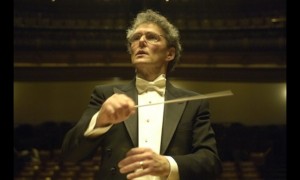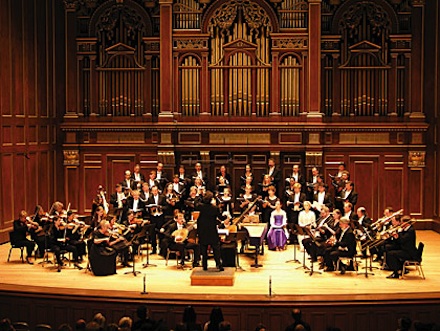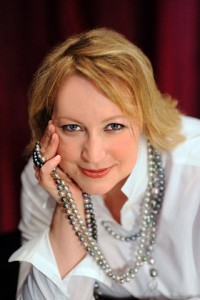Fuse Concert Review: Boston Baroque at Sanders Theater, January 1, 2012
Boston Baroque closed out 2011 and began 2012 with an engaging program of pieces by Corelli, Handel, Bach, and Vivaldi that featured some rather unfamiliar instruments and repertoire.
By Jonathan Blumhofer.
If in Vienna New Year’s means the annual Philharmonic concert of Strauss and Lanner, in Boston it means a pair of Last Night/First Night celebratory performances by the city’s Boston Baroque. This past weekend at Sanders Theater, the ensemble closed out 2011 and began 2012 with an engaging program of pieces by Corelli, Handel, Bach, and Vivaldi that featured some rather unfamiliar instruments and repertoire and concluded with an encore from a wholly unexpected source—but more on that later. Martin Pearlman, Boston Baroque’s founder and music director, conducted this thoroughly enjoyable concert.
Adding to the sense of occasion, Sunday’s performance (which was the one I attended) was broadcast live on WGBH; it can currently be streamed on demand from their website.
The program’s first work, Arcangelo Corelli’s Concerto Grosso in C major (op. 6, no. 10) made for a genial opening to the afternoon’s concert. The Baroque concerto grosso is a form that features a group of instrumental soloists that perform with and against the larger ensemble (called the ripieno). The soloists in this performance, Christina Day Martinson, Julie Leven (violins), and Sarah Freiberg (cello), were uniformly excellent, taking their solo turns and blending effectively with the larger ensemble.
In his pre-performance comments, Mr. Pearlman described the Corelli piece as “simple,” and there was a pleasantly straightforward quality to Boston Baroque’s reading. Throughout the piece, textures were clear and light, and the ensemble conveyed a great sense of the music’s character. In the fourth movement, particularly, there was some spirited interplay between the solo and ripieno groups, and the closing Minuetto was played with elegant restraint.
Handel’s Harp Concerto in B-flat (op. 4, no. 6) followed, and here we were introduced to our first unfamiliar instrument of the afternoon: the triple harp. Prior to the advent of the modern harp, with its system of pedals for quickly changing between sharps and flats, harpists had limited options for playing music that moved anywhere harmonically (as most tonal music does). One rather elaborate solution to this problem was the present instrument, which features three rows of strings: the outer rows are tuned to the key of the composition (in this case B-flat), while the inner row incorporates non-harmonic pitches (sharps, flats, and naturals not in the key signature. It all sounds rather complex and cumbersome, but our soloist this weekend, Barbara Poeschl-Edrich, made it look (and sound) easy.
The Harp Concerto is perhaps better known in one of its other guises, as an organ concerto Handel arranged as a showpiece for himself (and apparently it was one of his favorites), so the opportunity to hear it in its original setting was more than welcome. For the version with harp and orchestra, Handel employed some innovative orchestrations to allow the triple harp (which isn’t the loudest of instruments) to be heard. Accordingly, the piece features extended passages of unaccompanied harp solos and orchestral textures that anticipate later scoring by Chopin, Rodrigo, and others.
Ms. Poeschl-Edrich played the fast outer movements with much energy and clear phrasing, though perhaps the few excursions into the instrument’s lower range could have been brought out a bit more. The slow, second movement featured a beautiful, minor key melody that was finely shaped. Mr. Pearlman and the orchestra balanced the work’s delicate textures extremely well. Muted strings don’t regularly appear in Baroque music, so it was nice to hear the color they provided in the opening movement. The dance-like finale was wholly characteristic and sparkled.
Bach’s Concerto in D minor for two violins (BWV 1043) was the afternoon’s most familiar work, and Ms. Martinson and Ms. Leven realized the solo parts with characteristic drama and sensitive, understated feeling. Their performance of the motoric, outer movements captured the energy of this darkly turbulent score to fine effect. The slow, middle movement featured perhaps the most beautiful playing of the afternoon, in which Ms. Martinson and Ms. Leven effectively emphasized the dissonances Bach wrote for the violins.
After intermission, the second half of the program was dedicated to two pieces by Vivaldi.
The first, the Concerto in A minor for sopranino recorder (RV 445), featured Aldo Abreu as soloist. The sopranino recorder is roughly the size of a piccolo, though made of wood and not played transversely. Its timbre is a bit less strident, sounding like an organ stop (and, indeed, the Blockflöte stop derives its name from the recorder). Mr. Abreu, who serves on the faculty at Boston University, the Boston Conservatory, and New England Conservatory, is one of the great recorder players of the day, and his appearance at Sanders on Sunday was received with enthusiasm.
The Concerto itself is a nice enough piece, even if it sounds like any number of other Vivaldi concertos. Though the work’s musical material didn’t stick in my mind long after the concert, Mr. Abreu’s performance of the virtuosic solo part certainly did: his playing was nothing short of spectacular. In the first movement, the most involved of the three, he dispatched rapidly tongued arpeggiated figures with breathtaking agility and energy. The succinct, second movement allowed for a beautifully shaped, lyrical, sopranino recorder melody. The brisk finale brought back the character of the opening movement minus some of its acrobatics.
Mr. Pearlman and the Boston Baroque proved fine accompanists, giving nice shape to the Concerto’s dynamic shadings. I was particularly struck, in this performance, by the contrasts of texture between this work and the previous concerti we heard where Handel allowed extended unaccompanied solos and Bach created bustling orchestral sonorities, Vivaldi reduced to just one instrumental group (first violins, for instance) to accompany the soloist. Each texture was effective in its own context, and their juxtapositions on this program emphasized the rich stylistic diversity found among these four composers.
The final piece on the printed program was Vivaldi’s non-liturgical motet “Nulla in mundo pax sincera” (which translates as “In this world there is no genuine peace”). Soprano Mary Wilson, who has appeared regularly with Boston Baroque over the last couple of years, was soloist.
Ms. Wilson is a marvelous singer who possesses a voice with a clear, bell-like tone and superb diction: every word she sang came across clearly and crisply, even when one wasn’t looking at the Latin text. The vocal part of the motet’s four movements progresses from relatively simple, lyrical material to highly virtuosic, coloratura passages in the closing “Alleluia.” Ms. Wilson rendered her part with great sensitivity, blending especially effectively with the ensemble in the third movement and adding tasteful ornamentations to the repeated sections of her arias.
Mr. Pearlman brought a nice sense of phrasing to the proceedings and ensured a good balance between singer and orchestra. On the whole, tempos were on the quick side, which I found a good thing, though there was never a sense of rushing: everything felt natural and organic. If you didn’t get to attend either of these concerts, Ms. Wilson is returning to perform with the Boston Baroque in May for performances as Euridice in Gluck’s great opera Orfeo ed Euridice. Don’t miss her.
And what of this “unexpected” encore, you must be asking by now? Well, after the vocal pyrotechnics at the end of the Vivaldi, there were only a few places we might have gone, and the one we went to was very close to home, indeed: the aria “Glitter and be Gay” from Leonard Bernstein’s Candide. This was, to paraphrase Mr. Pearlman, one of (if not the only) time to hear Candide played on Baroque instruments, and I, for one, thought Bernstein’s lush score lent itself surprisingly well to an ensemble of strings and continuo. Ms. Wilson was totally in her element, and the crowd ate up her performance. One got the sense that Lenny, too, wherever he might be, was smiling with us as we all filed out into the mild, January air.



